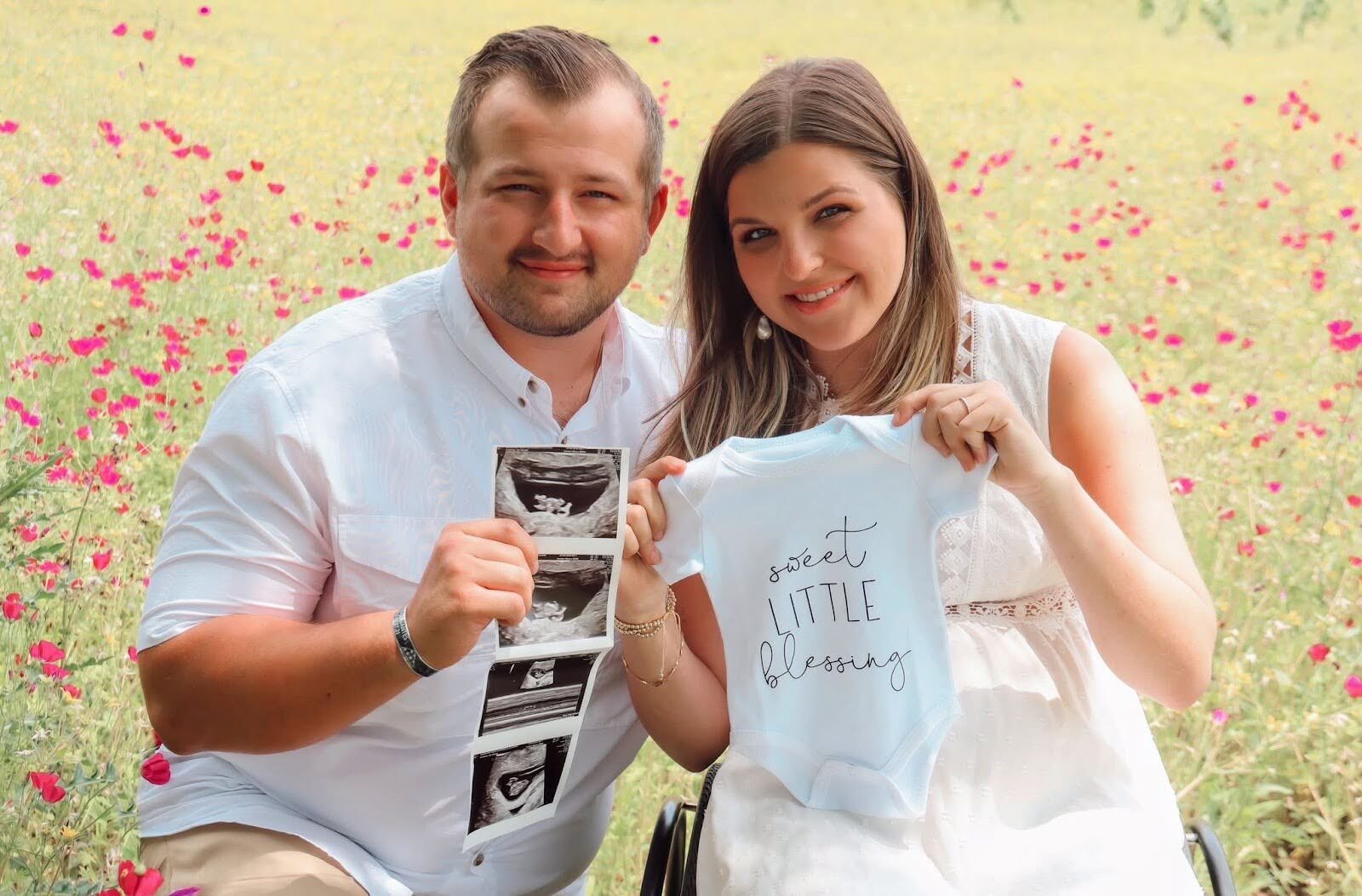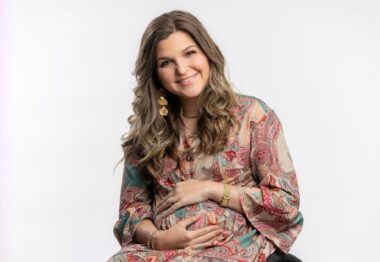I’m ready to welcome my new baby with ‘courage and grace’
Madelyn Raynsford, who has Friedreich's ataxia, will lean on family, community

Madelyn and her husband, Riley, announce their pregnancy with ultrasound pictures and a baby's onesie. (Courtesy of Madelyn Raynsford)
On a hot, Texas afternoon, Madelyn Raynsford’s home buzzes with the practical chaos of preparing for a new life: half-packed boxes, baby gear spread out, her two dogs lounging nearby. Her computer screen is filled with tabs researching safe and adaptive feeding options.
Baby bottles top the list — not glass, she decides, since breakage isn’t an option for hands that don’t always cooperate with cleanup. Instead, she bookmarks medical-grade silicone bottles with soft, easy grips.
For Raynsford, who was diagnosed with Friedreich’s ataxia (FA) at 13 and has used a wheelchair for several years, function matters more than style.
“You think about all the things you’ll need, and suddenly it’s less about what’s ‘cute’ and more about what lets you actually be there for your baby. I want to do as much as possible on my own,” she says.
That mindset also shapes bigger decisions — like where she’ll spend the early months of motherhood. Soon, Raynsford and her husband, Riley, will move in with her parents for the daily, in-person support she’ll need with a newborn.
Raynsford’s story is more than the usual anticipation of first-time motherhood. It involves genetic counseling, conversations with family, and connecting with other FA moms — all to pave the way for her journey into motherhood with FA.
“The overarching piece of advice that I hear from the other FA moms I talk with is you just gotta figure it out. And it’s going to look different, but you do what is needed,” she says.
Genetic counseling before pregnancy
Before starting their family, Raynsford and her husband wanted to fully understand the risks and possibilities of having a child with FA.
“The first step was to get Riley tested for the Friedreich’s ataxia gene. We went to a genetic counselor, and had him tested with a blood draw. It came back within two weeks that he was not a carrier,” she says.
This means their child cannot inherit FA, but may be a carrier of the gene, as the child would receive one copy of the FA gene from Raynsford. But because her husband doesn’t have a similar copy, the child will not develop the condition.
Genetic counseling is among the proactive steps FAers and their partners may need to take before conception. For Raynsford and her husband, these conversations and tests weren’t just procedural. They were an act of care, giving them real numbers, clear paths, and reassurance at a time of uncertainty.
If the results had been different, the couple would have explored other paths to parenthood.
“We probably would have thought about a different route and maybe done adoption or gone through IVF,” she says. “There would have been a different way that we could have been parents and shared the love that we have.”
The process of genetic counseling and receiving clear answers brought relief and focus. Knowing her husband was not a carrier “made everything less scary.” With this knowledge, Raynsford and her husband were able to move forward confidently as they prepared for the next stage in their journey toward parenthood.
For others in the FA community who may be considering pregnancy, connecting with a genetic counselor can offer the same kind of clarity and peace of mind. Organizations like the National Ataxia Foundation and the Friedreich’s Ataxia Research Alliance (FARA) can help connect individuals with certified genetic counselors and offer information on finding testing centers.

Madelyn Raynsford, who has Friedreich’s ataxia, is preparing to deliver her first child and for motherhood. (Courtesy of Madelyn Raynsford)
Communicating with the FA healthcare team
Pregnancy and FA can demand more than routine prenatal care. For Raynsford, being able to communicate openly with a coordinated team of medical specialists is essential to safely manage the months ahead of delivering a baby.
“They reassured me multiple times that through delivery, they would all be on the same page and communicate together,” she says.
That coordination proved valuable when Raynsford began having alarming cardiac concerns.
“I found out I was pregnant, and then three days later, I started having horrible chest pains, said Raynsford, whose body’s response to pregnancy triggered a change in how it metabolized her cardiac medications. “It was like my body knew that I was carrying a child. It started going through my beta blocker so fast.”
Prompt cardiology intervention became vital. “I had to get in with the cardiologist to figure out the medicines,” she says, adding that her heart symptoms are now under control. “We had to figure out dosages and when to take them and that kind of stuff.”
Alongside cardiac care, Raynsford’s pregnancy has involved regular check-ins with her neurologist and OB-GYN. Together, they monitor how her pregnancy may affect her FA symptoms, including coordination, fatigue, and blood sugar levels, while staying alert for any signs of complications.
For many women with FA, this kind of team-based care is crucial. Pregnancy may bring on new or shifting challenges — from increased neurological symptoms to urinary urgency or gestational diabetes. But with consistent communication and proactive monitoring, providers can respond quickly, offering adjustments or interventions to help keep both mom and baby healthy.
In Raynsford’s case, having a team that listens, adapts, and works together has been key, not just for managing symptoms, but for giving her the confidence to move through pregnancy with peace of mind.
Finding strength in community
For Raynsford, connecting with other women living with FA has made a profound difference as she prepares for motherhood.
“Texting other FAers who have children, or are currently pregnant, or just had a baby has been great. There’s a mom not too far away from me who just had her fourth baby,” she says. “I would say my biggest resource is reaching out to peers who have gone through the same thing that I have.”
Support from those who understand pregnancy with FA can offer reassurance, practical advice, and inspiration. Raynsford’s experience shows how important it can be to share not only challenges, but also to find solutions and encouragement.
For those seeking connection, support groups and organizations focused on FA provide a ready-made community. In the U.S., the National Ataxia Foundation offers a network of support groups, as well as virtual options, for people across the country.
FARA also offers parent and patient support groups, educational events, and a guide to living with FA. Internationally, Ataxia Canada connects people with familial ataxias, as does Ataxia UK.
Social media platforms can also be a place to find peer support, shared experiences, and adaptive parenting advice, especially from other FA moms.
Delivery, baby, and beyond
As Raynsford approaches the final stages of her pregnancy, she faces the universal anticipation and preparation that comes with expecting a first child.
Her coordinated medical team is ready to support her through delivery, with her OB-GYN, cardiologist, and neurologist all making plans for the birth in late autumn.
Yet, amid all the planning and contingencies, Raynsford says she’s uncharacteristically calm about how the delivery will unfold. When it comes to labor and delivery, she’s ready to go with the flow, a mindset that captures the balance between planning and acceptance.
“I’m very much a planning type of person,” she says. “Yet for this, I’m at peace with the whole delivery concept. However this baby makes it into the world, if they’re safe, mom’s safe, if we’re both healthy, it is what it is.”
Beyond delivery, Raynsford knows that FA will present ongoing physical challenges that may require adaptations as she embraces motherhood — from using assistive devices to relying on her support network.
But with her dedicated care team, supportive family, and connected FA community, Raynsford is taking each step with courage and grace. She is ready to welcome her baby and embrace life beyond delivery.







